Selection for Ornamental Purposes of ‘Angela’ Myrtle (Myrtus communis L.) Cultivar with Unpigmented Fruit
Abstract
1. Introduction
2. Materials and Methods
2.1. Sampling, Morphological and Biometric Analysis, and Phenology Study of Myrtle Cultivar
2.2. Trials of Agamic Propagation of Myrtle Cultivar
2.3. Statistical Analyses
3. Results
3.1. Morphological and Biometric Analysis and Phenology of Myrtle Cultivars
3.2. Agamic Propagation of Myrtle Cultivars
4. Discussion and Conclusions
Author Contributions
Funding
Conflicts of Interest
References
- Barbera, G.; Cullotta, S. The traditional Mediterranean polycultural landscape as cultural heritage: Its origin and historical importance, its agro-silvo-pastoral complexity and the necessity for its identification and inventory. In Biocultural Diversity in Europe. Environmental History; Agnoletti, M., Emanueli, F., Eds.; Springer: Cham, Switzerland, 2016; pp. 21–48. [Google Scholar] [CrossRef]
- Mulas, M.; Deidda, P. Domestication of woody plants from Mediterranean maquis to promote new crops for mountain lands. Acta Hortic. 1998, 457, 295–301. [Google Scholar] [CrossRef]
- Gildemeister, H. Mediterranean Gardening. A Waterwise Approach; University of California Press: Berkely/Los Angeles, CA, USA, 2002. [Google Scholar]
- Mulas, M. The myrtle (Myrtus communis L.) case: From a wild shrub to a new fruit crop. Acta Hortic 2012, 948, 235–242. [Google Scholar] [CrossRef]
- Messaoud, C.; Boussaid, M. Myrtus communis berry color morphs: A comparative analysis of essential oils, fatty acids, phenolic compounds, and antioxidant activities. Chem. Biodivers. 2012, 8, 300–310. [Google Scholar] [CrossRef]
- Medda, S.; Sanchez-Ballesta, M.T.; Romero, I.; Dessena, L.; Mulas, M. Expression of structural flavonoid biosynthesis genes in dark-blue and white myrtle berries (Myrtus communis L.). Plants 2021, 10, 316. [Google Scholar] [CrossRef] [PubMed]
- Aydın, C.; Özcan, M.M. Determination of nutritional and physical properties of myrtle (Myrtus communis L.) fruit growing wild in Turkey. J. Food Eng. 2007, 79, 453–458. [Google Scholar] [CrossRef]
- Mulas, M.; Cani, M.R.; Brigaglia, N. Characters useful to cultivation in spontaneous populations of Myrtus communis L. Acta Hortic. 1998, 457, 271–278. [Google Scholar] [CrossRef]
- Mulas, M.; Cani, M.R.; Brigaglia, N.; Deidda, P. Study of myrtle (Myrtus communis L.) genetic resources to promote extensive crop as integration of spontaneous harvests. Acta Hortic. 1999, 502, 85–88. [Google Scholar] [CrossRef]
- Mulas, M.; Cani, M.R. Germplasm evaluation of spontaneous myrtle (Myrtus communis L.) for cultivar selection and crop development. J. Herbs Spices Med. Plants 1999, 6, 31–49. [Google Scholar] [CrossRef]
- Zilkah, S.; Goldschdmidt, E.E. Myrtle (Myrtus communis L.)—A native Mediterranean and cultured crop species. In Medicinal and Aromatic Plants of the Middle-East. Medicinal and Aromatic Plants of the World; Yaniv, Z., Dudai, N., Eds.; Springer: Dordrecht, The Netherlands, 2014. [Google Scholar] [CrossRef]
- Holcomb, E.J.; Michalas, P.J. Myrtle as a flowering potted plant. Minn. Commer. Flower Grow. Bull. 1996, 45, 12–16. [Google Scholar]
- Bruna, S.; Portis, E.; Cervelli, C.; De Benedetti, L.; Schiva, T.; Mercuri, A. AFLP-based genetic relationships in the Mediterranean myrtle (Myrtus communis L.). Sci. Hortic. 2007, 113, 370–375. [Google Scholar] [CrossRef]
- Lim, T.K. Myrtus communis. In Edible Medicinal and Non Medicinal Plants; Springer: Dordrecht, The Netherlands, 2012. [Google Scholar] [CrossRef]
- Santos, M.F.; Lucas, E.; Sano, P.T.; Buerki, S.; Staggemeier, V.G.; Forest, F. Biogeographical patterns of Myrcia sl (Myrtaceae) and their correlation with geological and climatic history in the Neotropics. Mol. Phylogenetics Evol. 2017, 108, 34–48. [Google Scholar] [CrossRef]
- Ulloa-Inostroza, E.M.; Ulloa-Inostroza, E.G.; Alberdi, M.; Peña-Sanhueza, D.; González-Villagra, J.; Jaakola, L.; Reyes-Díaz, M. Native Chilean Fruits and the Effects of their Functional Compounds on Human Health. In Superfood and Functional Food. An Overview of Their Processing and Utilization; Waisundara, V., Shiomi, N., Eds.; IntechOpen: Rijeka, Croatia, 2017; pp. 99–130. [Google Scholar] [CrossRef]
- Medda, S.; Mulas, M. Fruit quality characters of myrtle (Myrtus communis L.) selections: Review of a domestication process. Sustainability 2021, 13, 8785. [Google Scholar] [CrossRef]
- Kafkas, E.; Sadighazadi, S.; Yıldırım, H.; Kefayati, S. Volatile compounds of selected white and black myrtle (Myrtus communis L.) types from Mediterranean region of Turkey. J. Med. Plant Res. 2013, 7, 1244–1248. [Google Scholar]
- Hacıseferoğulları, H.; Özcan, M.M.; Arslan, D.; Ünver, A. Biochemical compositional and technological characterizations of black and white myrtle (Myrtus communis L.) fruit. Int. J. Food Sci. Technol. 2012, 49, 82–88. [Google Scholar] [CrossRef]
- Özcan, M.M.; Al Juhaimi, F.; Ahmed, I.A.M.; Babiker, E.E.; Ghafoor, K. Antioxidant activity, fatty acid composition, phenolic compounds and mineral contents of stem, leave and fruit of two morphs of wild myrtle plants. J. Food Meas. Charact. 2020, 14, 1376–1382. [Google Scholar] [CrossRef]
- Şan, B.; Yildirim, A.N.; Polat, M.; Yildirim, F. Chemical compositions of myrtle (Myrtus communis L.) genotypes having bluish-black and yellowish-white fruit. Erwerbs-Obstbau 2015, 57, 203–210. [Google Scholar] [CrossRef]
- Petretto, G.L.; Maldini, M.; Addis, R.; Chessa, M.; Foddai, M.; Rourke, J.P.; Pintore, G. Variability of chemical composition and antioxidant activity of essential oils between Myrtus communis var. Leucocarpa DC and var. Melanocarpa DC. Food chem. 2016, 197, 124–131. [Google Scholar] [CrossRef]
- Mulas, M.; Melis, R.A. Influence of growing area, year, season, and cultivar on the composition of myrtle leaves and infusions. HortScience 2008, 43, 549–553. [Google Scholar] [CrossRef]
- Messaoud, C.; Béjaoui, A.; Boussaid, M. Fruit color, chemical and genetic diversity and structure of Myrtus communis L. var. italica Mill. morph populations. Biochem. Syst. Ecol. 2011, 39, 570–580. [Google Scholar] [CrossRef]
- Yegin, S.Ç.; Güder, A. Investigation of Antioxidant Activities and Hypoglycemic Effect of Black and White Myrtle Fruit. Erzincan Üniversitesi Fen Bilim. Enstitüsü Derg. 2021, 14, 314–321. [Google Scholar]
- Medda, S.; Fadda, A.; Dessena, L.; Mulas, M. Quantification of Total Phenols, Tannins, Anthocyanins Content in Myrtus communis L. and Antioxidant Activity Evaluation in Function of Plant Development Stages and Altitude of Origin Site. Agronomy 2021, 11, 1059. [Google Scholar] [CrossRef]
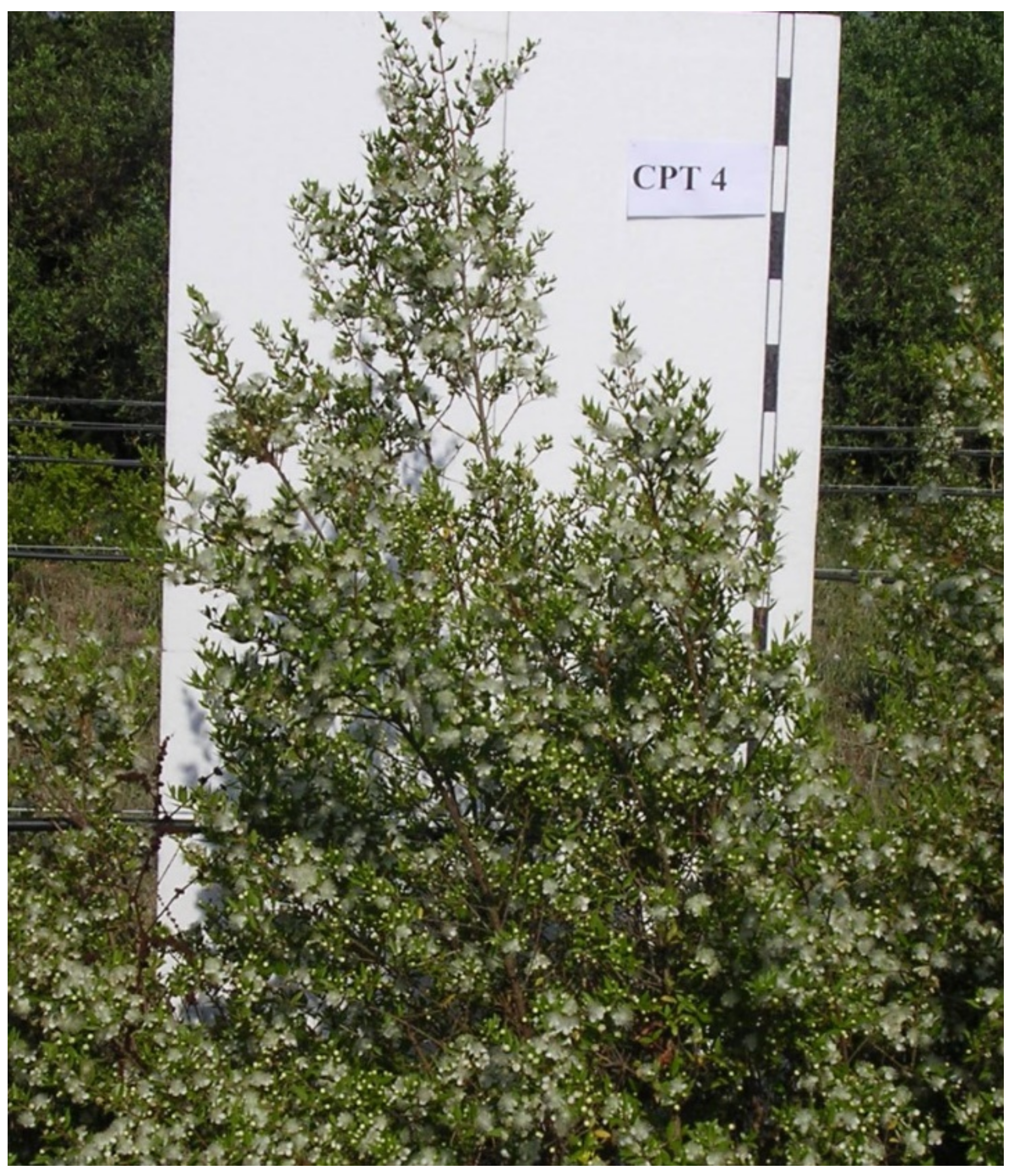
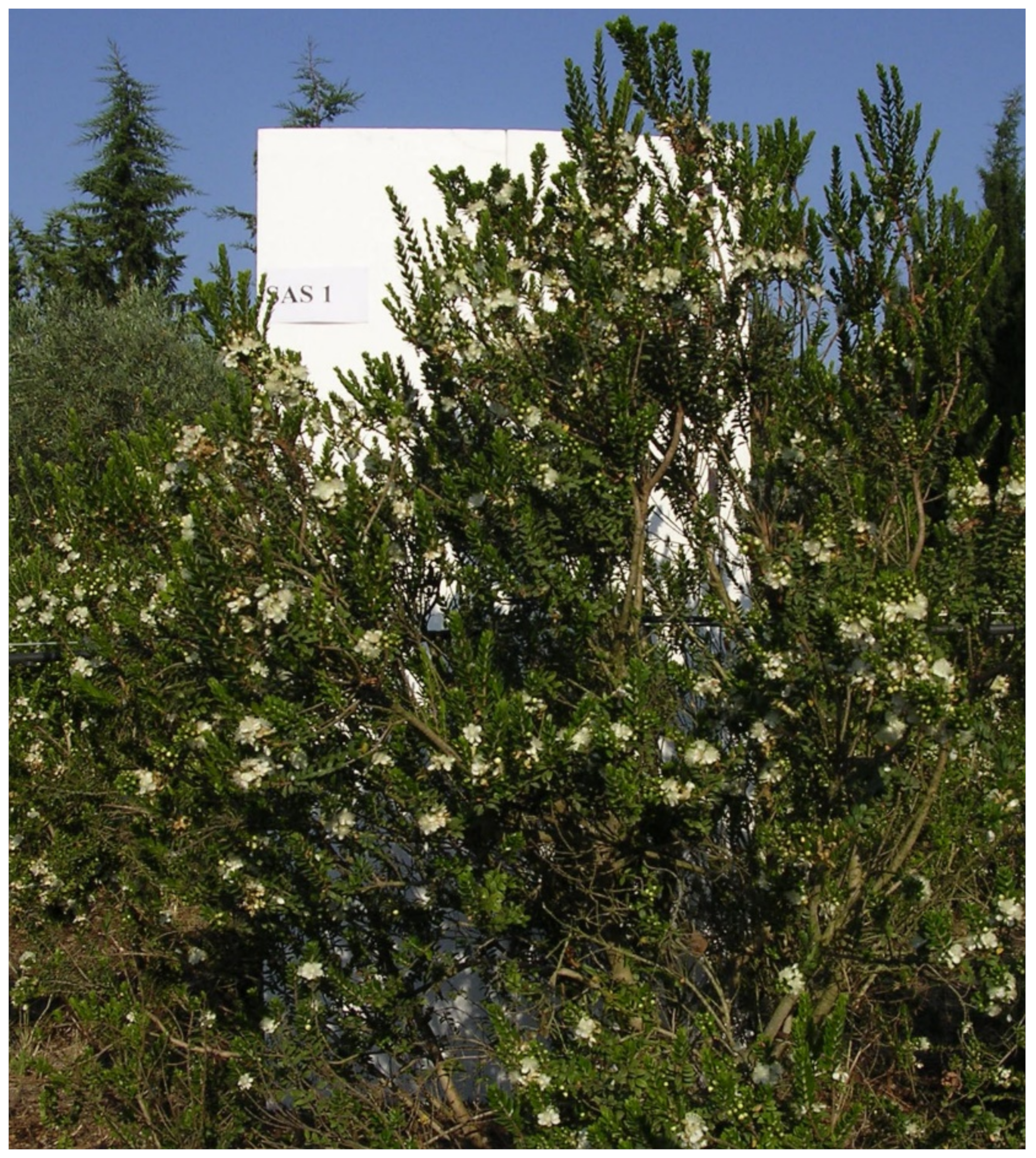
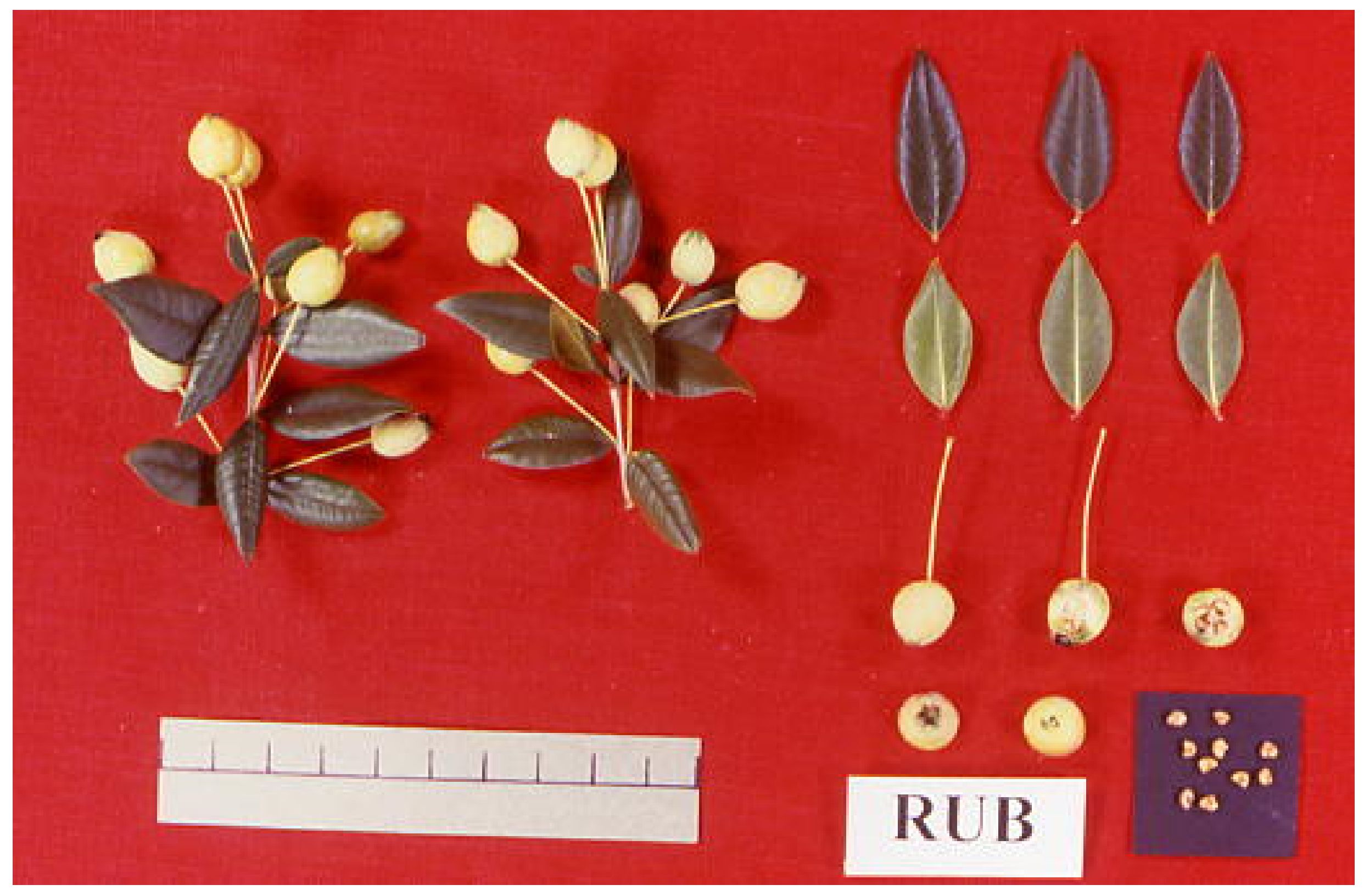


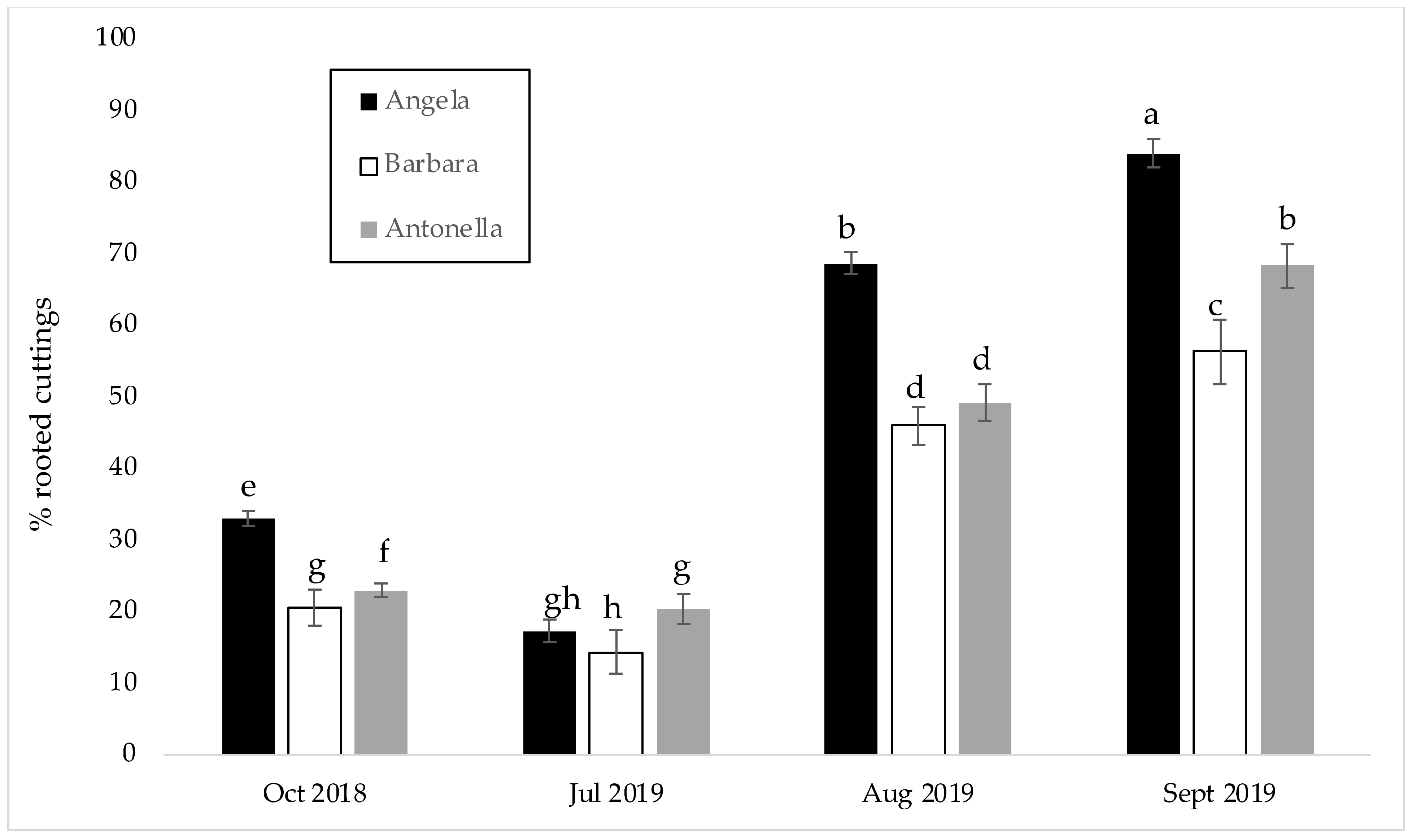

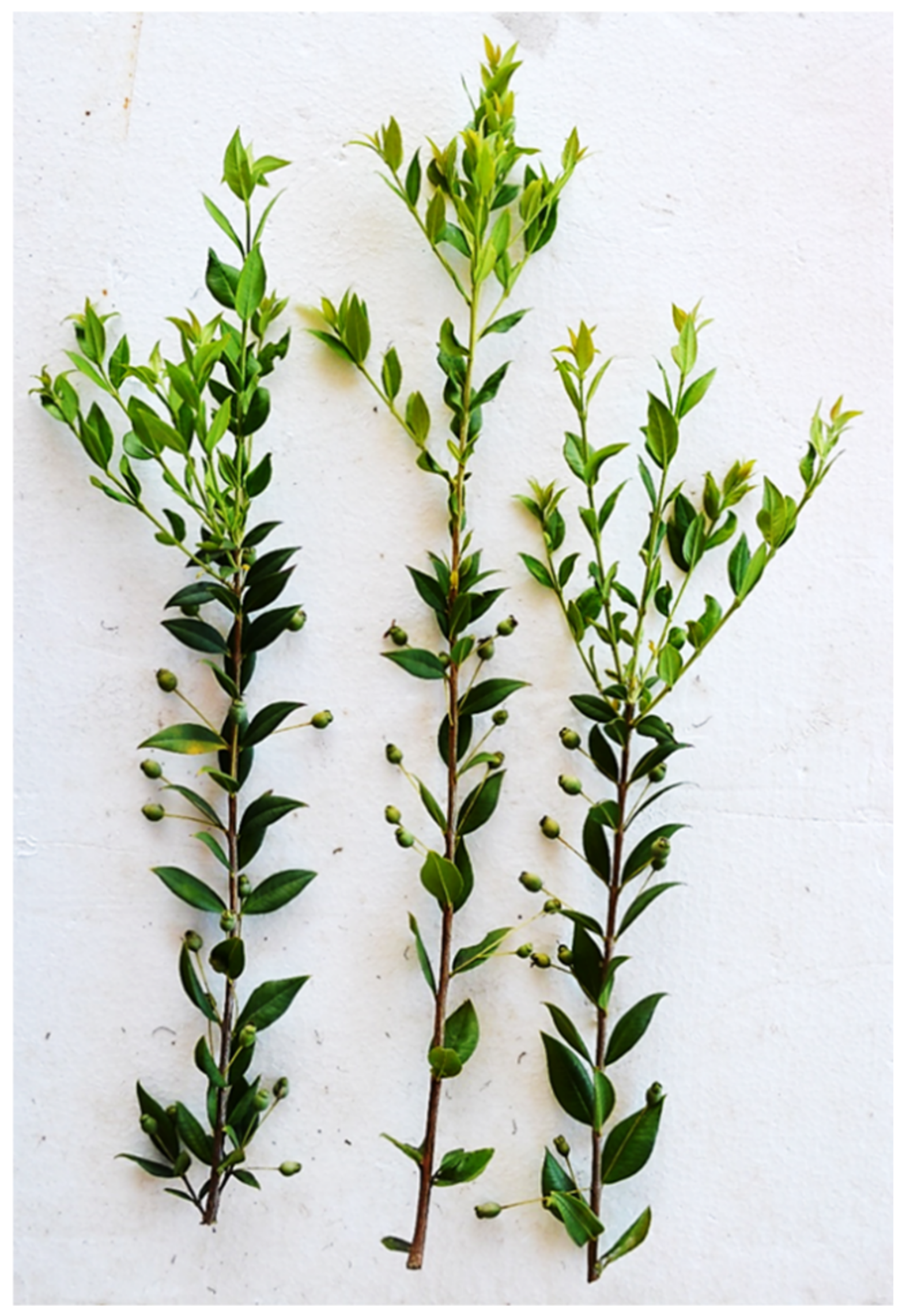
| Cultivar | Year | Blooming Shoot Length (cm) | n of Internodes per Blooming Shoot | n of Flowers per Blooming Shoot | n of Flowers per cm |
|---|---|---|---|---|---|
| Angela | 2018 | 9.40 ± 0.95 b | 7.97 ± 1.81 b | 8.70 ± 0.82 a | 0.93 ± 0.07 a |
| 2019 | 9.77 ± 0.15 b | 8.63 ± 0.40 b | 8.23 ± 0.15 a | 0.91 ± 0.07 a | |
| 2020 | 9.50 ± 0.60 b | 9.13 ± 0.45 b | 8.63 ± 0.45 a | 0.91 ± 0.04 a | |
| Barbara | 2018 | 8.39 ± 0.52 c | 7.68 ± 0.16 b | 4.57 ± 0.50 b | 0.55 ± 0.09 b |
| 2019 | 8.17 ± 0.69 c | 7.67 ± 0.23 b | 4.53 ± 0.31 b | 0.56 ± 0.05 b | |
| 2020 | 8.17 ± 0.34 c | 7.57 ± 0.30 b | 4.48 ± 0.20 b | 0.55 ± 0.03 b | |
| Antonella | 2018 | 10.67 ± 1.06 a | 24.12 ± 0.36 a | 3.25 ± 0.15 c | 0.30 ± 0.02 c |
| 2019 | 11.60 ± 0.67 a | 23.94 ± 0.67 a | 3.61 ± 0.05 c | 0.32 ± 0.02 c | |
| 2020 | 11.30 ± 0.17 a | 24.28 ± 0.73 a | 3.47 ± 0.28 c | 0.31 ± 0.02 c |
| Cultivar | Year | Corolla Diameter (cm) | n of Petals | Petals Length (cm) | Petals Width (cm) | Floral Peduncle Length (cm) |
|---|---|---|---|---|---|---|
| Angela | 2018 | 1.94 ± 0.34 a | 5.30 ± 0.17 ab | 0.87 ± 0.27 a | 0.64 ± 0.07 a | 2.48 ± 0.10 a |
| 2019 | 1.67 ± 0.73 a | 5.20 ± 0.10 b | 0.87 ± 0.20 a | 0.65 ± 0.04 a | 2.47 ± 0.15 a | |
| 2020 | 2.02 ± 0.16 a | 5.27 ± 0.15 ab | 0.90 ± 0.20 a | 0.68 ± 0.05 a | 2.53 ± 0.08 a | |
| Barbara | 2018 | 1.91 ± 0.03 a | 5.27 ± 0.15 ab | 0.78 ± 0.04 a | 0.62 ± 0.02 b | 1.29 ± 0.02 b |
| 2019 | 1.96 ± 0.03 a | 5.33 ± 0.25 ab | 0.74 ± 0.04 a | 0.65 ± 0.03 a | 1.26 ± 0.02 b | |
| 2020 | 1.95 ± 0.03 a | 5.37 ± 0.15 ab | 0.77 ± 0.02 a | 0.63 ± 0.01 ab | 1.27 ± 0.03 b | |
| Antonella | 2018 | 1.88 ± 0.04 a | 5.53 ± 0.32 ab | 0.83 ± 0.03 a | 0.57 ± 0.03 cd | 0.72 ± 0.01 c |
| 2019 | 1.85 ± 0.03 a | 5.70 ± 0.10 a | 0.84 ± 0.03 a | 0.57 ± 0.02 cd | 0.70 ± 0.05 c | |
| 2020 | 1.85 ± 0.04 a | 5.70 ± 0.26 a | 0.84 ± 0.04 a | 0.54 ± 0.03 d | 0.70 ± 0.03 c |
| Cultivar | Year | Style Length (cm) | Stamen Length (cm) | n of Stamens per Flower |
|---|---|---|---|---|
| Angela | 2018 | 1.22 ± 0.10 ab | 0.83 ± 0.21 c | 154.63 ± 30.16 ab |
| 2019 | 1.24 ± 0.04 a | 0.88 ± 0.10 c | 146.00 ± 11.00 ab | |
| 2020 | 1.26 ± 0.02 a | 0.86 ± 0.15 c | 164.00 ± 10.54 a | |
| Barbara | 2018 | 0.99 ± 0.02 e | 0.94 ± 0.02 a | 146.00 ± 4.58 ab |
| 2019 | 1.00 ± 0.03 de | 0.96 ± 0.02 a | 145.33 ± 4.04 ab | |
| 2020 | 0.99 ± 0.04 de | 0.94 ± 0.02 ab | 149.00 ± 2.65 ab | |
| Antonella | 2018 | 1.11 ± 0.02 c | 0.86 ± 0.02 c | 138.00 ± 1.00 b |
| 2019 | 1.09 ± 0.03 cd | 0.88 ± 0.02 bc | 140.33 ± 3.06 b | |
| 2020 | 1.12 ± 0.02 bc | 0.86 ± 0.02 c | 138.00 ± 2.65 b |
| Cultivar | Year | Twig Length (cm) | n Internodes per Twig | n Fruit per Twig | Leaf Length (cm) | Leaf Width (cm) |
|---|---|---|---|---|---|---|
| Angela | 2018 | 11.52 ± 1.31 a | 9.26 ± 1.07 b | 6.16 ± 0.40 a | 3.30 ± 0.18 a | 1.35 ± 0.08 b |
| 2019 | 11.30 ± 0.56 a | 9.46 ± 0.55 b | 6.30 ± 0.20 a | 3.32 ± 0.03 a | 1.40 ± 0.03 ab | |
| 2020 | 11.00 ± 0.36 a | 9.13 ± 0.25 bc | 6.10 ± 0.26 a | 3.45 ± 0.03 a | 1.44 ± 0.05 a | |
| Barbara | 2018 | 8.58 ± 0.64 b | 8.33 ± 0.31 cd | 3.83 ± 0.97 b | 2.09 ± 0.09 b | 0.89 ± 0.05 b |
| 2019 | 8.37 ± 0.64 b | 7.93 ± 0.15 d | 3.70 ± 0.20 b | 2.08 ± 0.08 b | 0.91 ± 0.02 b | |
| 2020 | 8.33 ± 0.42 b | 7.73 ± 0.21 d | 3.67 ± 0.25 b | 1.97 ± 0.03 b | 0.88 ± 0.04 b | |
| Antonella | 2018 | 11.81 ± 0.97 a | 25.30 ± 0.44 a | 2.57 ± 0.35 c | 1.23 ± 0.12 c | 0.57 ± 0.02 c |
| 2019 | 11.97 ± 0.42 a | 24.83 ± 0.31 a | 2.67 ± 0.15 c | 1.19 ± 0.05 c | 0.59 ± 0.02 c | |
| 2020 | 11.60 ± 0.20 a | 25.06 ± 0.32 a | 2.33 ± 0.25 c | 1.26 ± 0.02 c | 0.57 ± 0.02 c |
| Cultivar | Year | Fruit Weight (g) | Fruit Volume (mL) | Fruit Width (cm) | Fruit Length (cm) | Peduncle Length (cm) |
|---|---|---|---|---|---|---|
| Angela | 2018 | 0.52 ± 0.03 a | 0.66 ± 0.05 a | 1.03 ± 0.02 a | 1.24 ± 0.03 a | 2.64 ± 0.03 a |
| 2019 | 0.53 ± 0.03 a | 0.64 ± 0.03 a | 1.05 ± 0.02 a | 1.26 ± 0.02 a | 2.71 ± 0.02 a | |
| 2020 | 0.53 ± 0.03 a | 0.67 ± 0.03 a | 1.03 ± 0.02 a | 1.25 ± 0.03 a | 2.71 ± 0.03 a | |
| Barbara | 2018 | 0.37 ± 0.01 b | 0.44 ± 0.02 b | 0.84 ± 0.01 b | 1.15 ± 0.01 b | 1.36 ± 0.09 b |
| 2019 | 0.36 ± 0.03 b | 0.44 ± 0.02 b | 0.84 ± 0.02 b | 1.15 ± 0.01 b | 1.32 ± 0.08 b | |
| 2020 | 0.37 ± 0.02 b | 0.43 ± 0.03 b | 0.85 ± 0.03 b | 1.15 ± 0.03 b | 1.35 ± 0.07 b | |
| Antonella | 2018 | 0.17 ± 0.03 c | 0.18 ± 0.03 c | 0.70 ± 0.02 c | 0.79 ± 0.02 c | 0.69 ± 0.05 c |
| 2019 | 0.16 ± 0.01 c | 0.18 ± 0.01 c | 0.71 ± 0.02 c | 0.81 ± 0.03 c | 0.72 ± 0.02 c | |
| 2020 | 0.18 ± 0.01 c | 0.18 ± 0.02 c | 0.70 ± 0.02 c | 0.80 ± 0.04 c | 0.69 ± 0.03 c |
Publisher’s Note: MDPI stays neutral with regard to jurisdictional claims in published maps and institutional affiliations. |
© 2022 by the authors. Licensee MDPI, Basel, Switzerland. This article is an open access article distributed under the terms and conditions of the Creative Commons Attribution (CC BY) license (https://creativecommons.org/licenses/by/4.0/).
Share and Cite
Medda, S.; Fadda, A.; Mulas, M. Selection for Ornamental Purposes of ‘Angela’ Myrtle (Myrtus communis L.) Cultivar with Unpigmented Fruit. Sustainability 2022, 14, 13210. https://doi.org/10.3390/su142013210
Medda S, Fadda A, Mulas M. Selection for Ornamental Purposes of ‘Angela’ Myrtle (Myrtus communis L.) Cultivar with Unpigmented Fruit. Sustainability. 2022; 14(20):13210. https://doi.org/10.3390/su142013210
Chicago/Turabian StyleMedda, Silvia, Angela Fadda, and Maurizio Mulas. 2022. "Selection for Ornamental Purposes of ‘Angela’ Myrtle (Myrtus communis L.) Cultivar with Unpigmented Fruit" Sustainability 14, no. 20: 13210. https://doi.org/10.3390/su142013210
APA StyleMedda, S., Fadda, A., & Mulas, M. (2022). Selection for Ornamental Purposes of ‘Angela’ Myrtle (Myrtus communis L.) Cultivar with Unpigmented Fruit. Sustainability, 14(20), 13210. https://doi.org/10.3390/su142013210











